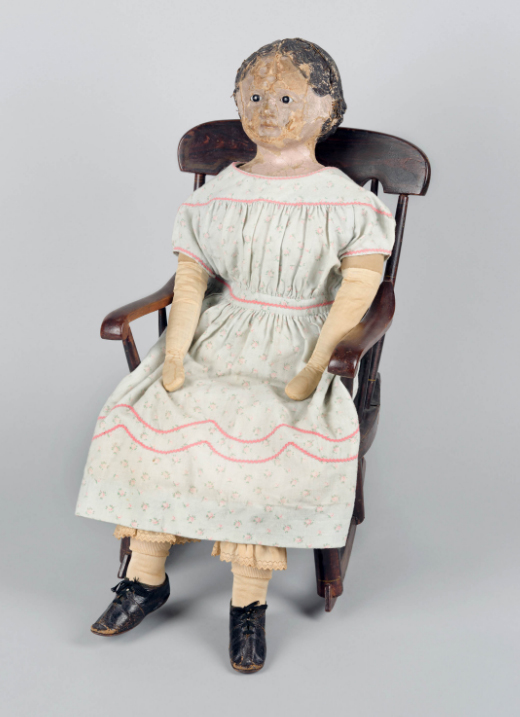By Meg Szydlik, Visitor Services Coordinator
If you’ve paid any attention to the internet recently you may be aware that the movies Barbie and Oppenheimer just came out. While completely tonally different, many people are watching them as a double feature and the “correct” order for doing so is hotly debated. Personally, I plan to see Oppenheimer first and then Barbie. This is the order recommended by most of my friends who have seen the films. With all the excitement about the movies, I decided to dig around and see what the MHS collection has to offer related to either movie. It turns out, we have quite a few relevant items that I want to highlight here.

The first is “Rebeccah,” a doll from the 19th century with a fascinating and somewhat romantic history. While she has no Ken counterpart, she had plenty of experience with Transcendentalist culture at Brooks Farm and presumably lived a very happy existence among the children. Founded in 1841, Brooks Farm was meant to be a communal utopia but ultimately failed in 1846. By the doll’s own account (a letter pinned to her petticoat when she arrived) she had a happy life inside the commune as well as out and was enjoyed by generations of children. Though she is made of cloth and porcelain rather than the plastic of Barbies, Rebeccah fulfills the same basic function. She is a toy, but one filled with meaning and the expectations of what women and girls are meant to be. While she no longer fulfills that function and instead spends her time in our stacks, she still provides insight into girlhood in the 19th century.
The Barbie movie is, of course, not the only movie in this “double-header” summer flick extravaganza.
Oppenheimer is a biopic looking at the creation and aftermath of the atomic bomb through the complicated life of the scientific director of the project. Nuclear weapons remain a contentious topic and conversations about nuclear proliferation are picking up, which makes this film especially timely. Within the MHS collections are the Sen. Leverett Saltonstall Bikini Atoll Papers, which chronicle Senator Saltonstall’s experience of seeing the 1946 Able and Baker tests detonate in the Pacific. Reading these documents and examining the photographs, it is clear how destructive the bombs were, to the point that Bikini Atoll is still not habitable, nearly 70 years after the last test. Carl A. Hatch, chair of the Evaluation Commission for Operation Crossroads, noted in his message to President Truman after the Baker test bomb that:
As was demonstrated by the terrible havoc wrought at Hiroshima and Nagasaki, the Bikini tests strongly indicate that future wars employing atomic energy may well destroy nations and change present standards of civilization.
To us who have witnessed the devastating effects of these tests, it is evident that if there is to be any security or safety in the world, war must be eliminated as a means of settling differences among nations.

And Hatch was not alone. As early as 1946, the “father of the atomic bomb” was lobbying hard against the further use of the bombs he shepherded through creation, despite his advocacy prior. Oppenheimer maintained a strong anti-nuclear weapons stance for the rest of his life.
While on the surface neither movie has much in common with the other and neither do the collection materials I pulled for this blog, I appreciate the juxtaposition of two radically different stories coming out on the same day. The thrilling intensity of the Oppenheimer story paints a picture of a horribly destructive weapon of war and the minds who created it. The spirit of Barbie is bright pink and sparkly and fun but presents interesting conversations about power and who has it. Both films tell us something about what humans care about and are interested in exploring. They ask what we think is worth saving, which is reflected in the collections of the MHS.
**Note that WGA(https://www.wgacontract2023.org/) and SAG-AFTRA(https://www.sagaftra.org/) are on strike, which includes those who worked on these films. I fully support the strike, however neither union has called for a consumer boycott.**

